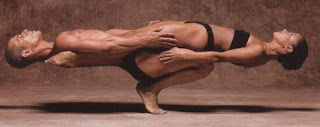Goddesses and Gods as Equal Companions
Think of a pendulum.
via GIPHY
The eastern symbol of Yin-Yang, which has become so
ubiquitous, is a perfect representation of this state of male/female energy
balance. The male Yang represents the bright sun of day, strength, positive
magnetic charge, and heaven. The female Yin represents the dark moon of night,
nurturing, cool waters, negative magnetic charge, and earth. Both of which
cannot exist without the other.
In Hindu philosophy, the divine couple Shiva and Shakti represent the two essential aspects of the One. The belief is that the entire universe was created and sustained by these two forces. Shiva represents the masculine principle of the abiding aspect of the elements of the universe. Shakti represents the feminine principle of the energy force that make these elements come to life. Neither have any substantive power without the other.
via GIPHY
Its movement is to extremes. It swings as far as it can to
one direction so that is can gather the energy to swing back to the opposite
direction. This extreme opposition of movement creates complete balance in the
pendulum’s swing.
However, in order to have that perfection of balance, the
pendulum must go to the furthest on each side in order to have the momentum to
return to the opposite side.
I see this as a metaphor for my reclamation of the feminine
divine. In order to have a balance of both the masculine and feminine, first I
needed to immerse myself in and reclaim the goddess. Only then could I also
embrace the god and their balance with each other.
I am drawn to a spirituality
that is balanced. Rather than a faith that only worships an omniscient
father-god who sits in judgement – as easily ready to punish as to praise – I
choose an equilibrium of both mother and father energies from which to draw
inspiration, knowledge, and wisdom.
In modern day mainstream religions the female is represented
as either a god’s wife, or concubine, or mother, or mother of his children. But
in old religions, not only did the goddess hold equal power with the god, but
in many cases she was held in greater esteem as the giver of life – the Great
Mother. (see previous post for more details on The Great Mother)
Examples of this equal partnership can be found all over the
world:
Known as Lady of the Sea, the Goddess Asherah was the
consort and beloved of the Hebrew God Yahweh. Asherah’s domain was the waters
and Yahweh ruled the heavens, and they were seen as God-the-Father and God-the
Mother by ancient civilizations. She was removed from the Old Testament Hebrew
scriptures around 400 or 500 BCE.
In Hindu philosophy, the divine couple Shiva and Shakti represent the two essential aspects of the One. The belief is that the entire universe was created and sustained by these two forces. Shiva represents the masculine principle of the abiding aspect of the elements of the universe. Shakti represents the feminine principle of the energy force that make these elements come to life. Neither have any substantive power without the other.
In Roman mythology there are Rosmerta and Mercury, and the
Norse have Freya and Odin. These are just some other examples of many.
All of these pairs
share power equally and equally share in the respect and reverence of their
people.
As it should also
be in the realm of human relationships.




Comments
Post a Comment